
British postcard, no. 78. Photo: Lubin. Collection: Marlene Pilaete.
Cute Buster Johnson (1908-1969) was the most famous child star of the Lubin company. Only 3 1/2 years old, he was extremely popular in 1912. Buster Johnson was born in 1908 in Brooklyn, New York as Hoyt Roswell Johnson. His parents were Roswell Joshua Johnson, a film cameraman for Lubin, and Florence S. Johnson. He had a sister who was named Ormi Hawley Johnson. His godmothers were the film stars Ormetta Hawley and Mary Pickford. The adorable little boy made his debut in the silent short The Kiddies' Christmas (N.N., 1911) at the Lubin Manufacturing Company. He was presented in the media as 'Lubin's Child Wonder', who played "both boys and girls with intelligence". The short comedy Buster's Dream (Charles H. France, 1912) led to the Buster series with such films as Buster and the Cannibal's Child (Charles H. France, 1912), and Buster and the Gypsies (Charles H. France, 1912). His co-stars were the child actors Henrietta O'Beck en Brooks McCloskey. The following year, Buster appeared in his last film, ironically called His First Experience (Arthur Hotaling, 1913) in which he played the son of Mae Hotely. In 1914, the Lubin Company had a fire that resulted in financial problems. It’s possible that because of this, they couldn’t afford all the actors they had on the roster, and perhaps they had to drop him. In all, Buster was in 14 films. Census records show that in 1930, he was living with family and was a bookkeeper at a bank. In 1934 he was married to Vivien Isabel Mehrhof in Ridgefield, New Jersey. Buster Johnson died in 1969 in the USA. He was 61.
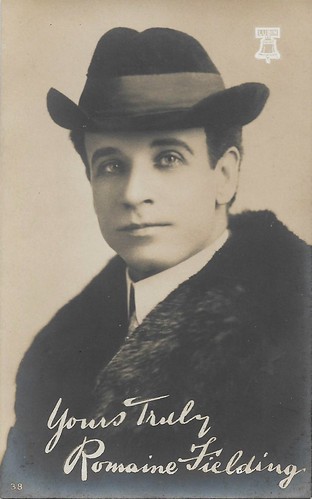
English postcard, no. 38. Photo: Lubin.
Romaine Fielding (1867-1927) was an American actor, screenwriter, and silent film director known for his dramatic Westerns. Fielding worked for the Solax Film Company of New York before joining Lubin in November 1911 at the age of 44. Despite his age, he could easily portray much younger characters. In June 1912 Siegmund Lubin placed Fielding in charge of the Lubin Southwest Company as director, despite the fact that until then he had only acted. It was the start of a rapid rise to fame. Fielding would write and direct films as well as star in them. He broke with convention, challenging stereotypical casting of Indians and Mexicans as villains, such as Who is the Savage? (1913), starring Mary Ryan, Fielding's regular co-star in these years. His films often ended unexpectedly on a downbeat note. His work was praised in the trade press for its visual beauty combined with realism. His five-reel thriller The Golden God (1914) employed about 5,000 local extras and featured a cavalry and artillery charge. At one time he filmed a train smash at great expense. Lubin used the costly footage in five different films. Fielding made a number of Mexican-themed Western-style films and adventure films on location in California, Arizona, and New Mexico, but little of his work has survived. In July 1913, Motion Picture Story magazine announced that Fielding had come top of their readers poll with 1,311,018 votes.
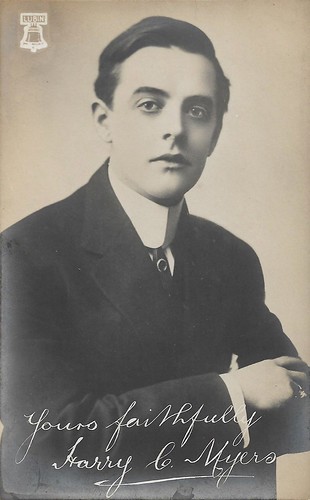
English postcard. Photo: Lubin.
American film actor and director Harry C. Myers (1882-1938) was married to the actress Rosemary Theby. Myers had been a theatre actor for 10 years before he went to work for Lubin in 1909. A still existing example of Myers' career at Lubin is the drama When the Earth Trembled (Barry O'Neill, 1913), possibly the first fiction film to depict the 1906 San Francisco earthquake.
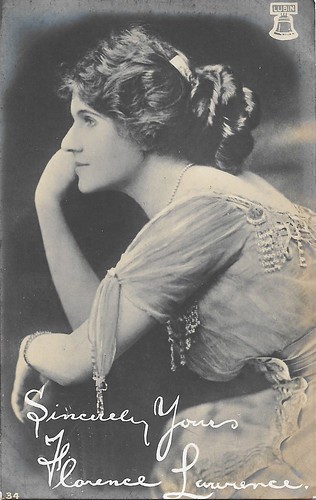
English postcard, no. 34. Photo: Lubin.
Canadian-born actress Florence Lawrence (1886-1938) began her career in the motion picture industry with a role in an Edison Company short, Daniel Boone/Pioneer Days in America (1907). Next, she worked for the Vitagraph Company. At the American Mutoscope and Biograph Company, Lawrence appeared in most of the sixty short films that D.W. Griffith directed in 1908. She became famous, known as “the Biograph girl.” In 1910, producer Carl Laemmle of the Independent Motion Picture Company (IMP) hired her. Lawrence was the object of a notorious publicity stunt. Her “death” in a streetcar accident was widely announced, followed by her resurrection in the first publicity tour in film history. Lawrence and her husband Harry Solter worked at IMP for eleven months and made approximately fifty films. Lawrence and Solter then joined Lubin in early 1911, but they left Lubin within a year, and, with Solter, started one of the first US film companies to be headed by a woman: the Victor Company.

English postcard, no. 44. Photo: Lubin.
Frank Spottiswoode Aitken (1868-1933) was a Scottish-American actor of the silent era. His film debut came at Lubin in the short comedy A Change of Heart (N.N., 1910) with Edna Luby. The following year, he appeared for Lubin in several shorts including Her Humble Ministry (Harry Solter, 1911) with Arthur V. Johnston and Florence Lawrence. Later, he played Dr. Cameron in D. W. Griffith's epic drama The Birth of a Nation (1915).
A running legal battle with Thomas Edison
Siegmund Lubin was born in Germany in 1851. He was educated at Heidelberg University and, following in the footsteps of his father, earned his degree in ophthalmology. Lubin traveled to the United States, first in 1868, and then immigrated permanently in 1876. He lived in New Haven, Connecticut, where he met his wife, Annie Abrams.
After they married, they traveled the United States together attending fairs and exhibitions where Lubin conducted eye examinations and sold eyeglasses. In 1882, after the birth of their daughter Edith, the family moved to Philadelphia where Lubin opened an optical shop at 237 North Eighth Street. His family occupied the second-floor apartment.
Lubin continued to travel around the country to attend exhibitions, and it was during a trip to New Orleans that he was first introduced to and became interested in the burgeoning field of Motion picture recording. "Pop" Lubin saw the potential in selling similar equipment as well as in making films. By 1896, Lubin had established his motion picture business, "Life Motion Pictures," using profits from his optical shop and the investments of family and friends.
He soon developed his own projector, the "Cineograph," that he manufactured, marketed, and sold to the general public, along with other varieties of projectors and films. His lower price and marketing know-how brought reasonable success. In 1897 Lubin began making films for commercial release. He staged and filmed re-enactments of famous boxing matches, battles of the Spanish-American War, and news stories.
Initially, Lubin filmed in parks and in his own backyard. Certain his business could prosper, the following year he rented low-cost space on the roof of a building in Philadelphia's business district where he built a more formal film studio. He exhibited his new equipment at the 1899 National Export Exposition in Philadelphia and the 1901 Pan-American Exposition in Buffalo, New York. In 1902, Lubin formed the Lubin Manufacturing Company and incorporated it in 1909 in Philadelphia, Pennsylvania. A notable film was Meet Me at the Fountain in 1904.
For years the Lubin Manufacturing Company, like most of the other major film studios, had a running legal battle with Thomas Edison that saw repeated lawsuits brought against Lubin for patent infringement. In 1908, Lubin gave up the costly fight with Edison and became part of the Motion Picture Patents Company, a monopoly on production and distribution set up by Edison.
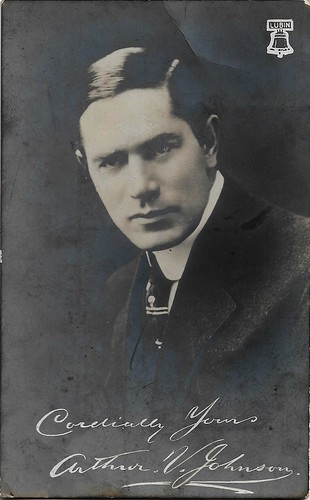
English postcard. Photo: Lubin.
Arthur V. Johnson (1876-1916) was a highly prolific American actor and director, known for his work at the pre-Hollywood companies of Edison, American Biograph, and Lubin. In 1911 Johnson accepted an offer from Lubin that allowed him to direct as well as act. With Lottie Briscoe, his frequent co-star at Lubin, Johnson directed and starred in The Beloved Adventurer (1914), a 15 episode serial by Emmett Campbell Hall. His high productivity took its toll: in 1915 he had a nervous breakdown due to overwork, he stopped his career, and died of TBC, almost forty.

English postcard. Photo: Lubin.
American stage actress May Buckley (1875-?) became a popular film heroine with the role of 'Marguerite Moreland' in the Lubin production Paid in His Own Coin (1912). The following year she moved on to Selig, but later that year, she left the film business. Her private life was often in newspaper headlines, especially in 1901, when a man who claimed to be her husband shot at her in a hotel dining room, wounding one of her dining companions.

English postcard, no. 40. Photo: Lubin.
American actor Noah Reynolds (?-1948) appeared in a dozen Lubin shorts between 1910 and 1912. He was known for such Lubin shorts as the Western Percy the Cowboy (1910) in which he played the title role, Making a Man of Him (1910) with Harry Myers, and Archibald the Hero (1911), again as the title figure. He died in 1948 in North Philadelphia, Pennsylvania, USA.

British postcard, no. 45. Photo: Gilbert & Bacon, Philadelphia / Lubin. Collection: Marlene Pilaete.
Eleanor Caines (1870 or 1880-1913) was an American silent film actress. She spent most of her film career at the Lubin Film Company. According to IMDb, Eleanor Caines was born in 1870 in Philadelphia, Pennsylvania, USA. In 1909, she began her film career at Lubin in the short comedy Blissville the Beautiful (1909) with George Reehm and Harry Myers. In the following years, she appeared in some 30 Lubin productions. Eleanor Caines died in 1913 in her hometown Philadelphia at the age of 43. The cause of her death was surgery after an accident. She was married to William Robson with whom she had a child, and till her death to Jack Le Faint.

British postcard, no. 121. Photo: Lubin. Collection: Marlene Pilaete.
American silent screen motion picture actress Edna Payne (1891-1953) is regarded as a 'pioneer' in the film industry because she was in many short films from 1911 through 1917.
Edna Payne was born in 1891 in New York City. Petite, blue-eyed, and brown-haired, Edna was born "in the trunk". Her parents were both stage actors, so Payne began her career as a child in Vaudeville. She made her film debut in Higgenses Versus Judsons (1911). She played the lead in reel dramas, and later in a few reel Westerns including The Girl Stage Driver (1914). Although her film career was confined to the 1910s, she took part in countless productions. In 1917 she finished her acting career when she married actor Jack Rollens. They had two children, Edna J (1919), and Jack A (1921), but the couple divorced in 1925. Edna Payne died of a liver ailment in 1953, aged 61, in Los Angeles, California.

English postcard. Photo: Lubin.
Mae Hotely (1872-1954) was a brunette early silent screen comedienne, who starred in films for Lubin, produced by her husband Arthur Hotaling out of Jacksonville, Florida. She appeared in 85 films between 1911 and 1929.
A state of the art studio named Lubinville
The insatiable appetite of the American public for films saw Lubin's company undergo enormous growth. Aided by French-born writer and poet Hugh Antoine D'Arcy, who served as the studio's publicity manager, in 1910 Siegmund Lubin built a state of the art studio on the corner of Indiana Avenue and Twentieth Street in Philadelphia that became known as "Lubinville." The studio included an open tank under the floor that could be flooded to stage scenes involving large volumes of water as well as a cutting edge lighting system for use on cloudy days. There were also costume rooms, property storage rooms for set building, an editing room, a laboratory, and a cafeteria.
The facility allowed several film productions to be undertaken simultaneously. Lubin began to invest in the quality of his films and actors, for the first time. He recruited famous actresses and actors, such as Florence Lawrence, Ormi Hawley, and John Halliday, who brought greater acclaim to his productions.
The Lubin Manufacturing Company expanded production beyond Philadelphia, with facilities at 750 Riverside Avenue in Jacksonville, Florida, Los Angeles, and then in Coronado, California. In 1912, Lubin purchased a 350-acre (1.4 km2) estate in Betzwood, in what was then rural countryside in the northwest outskirts of Philadelphia, and converted the property into a studio and film lot.
That same year, director and actor Romaine Fielding travelled out to Prescott, Arizona with cast and crew and set up offices at 712 Western Avenue and an outdoor stage for shooting interiors behind Mercy Hospital (now the site of Prescott College). He filmed approximately a dozen films there before moving to Tucson, Arizona, where he directed another 60 or so silent short films. William Duncan and Selig Polyscope Company took over the Prescott facility.

English postcard, no. 47. Photo: Lubin.
American actress Rita Davis is known for such early silent Lubin films as Three Hearts (N.N., 1910), Faith Lost and Won (1910), and The Widow's Choice (1911).

English postcard, no. 39. Photo: Lubin.
Ethel Elder was an American silent film actress who worked for the Lubin company. 'Miss Elder' is known for such short films as The Mystery (1912), The Path of Genius (1912), and Billy's Surrender (1912).
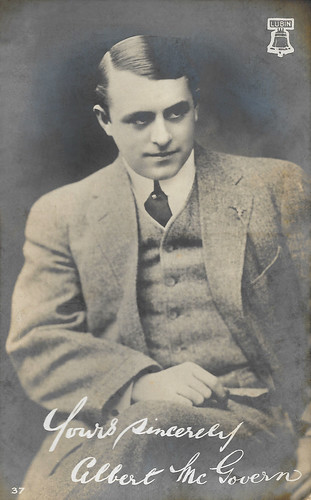
English postcard, no. 37. Photo: Lubin.
Albert McGovern (1882-?) was an American actor and director who worked for the Lubin company. Between 1910 and 1914 he played in more than 30 short silent films.

British postcard, no. 72. Photo: Lubin. Collection: Marlene Pilaete.
American actress Ormi Hawley (1889-1942) was a silent film actress who worked for the Lubin Manufacturing Company and later for Fox, Mutual, and Paramount. Dubbed "The Lillian Russell of the Pictures", she usually played gracious society roles or aristocrats. Between 1911 and 1919, she appeared in more than 300 pictures. Ormetta Grace Hawley was born in 1889 in Holyoke, Massachusetts. She attended the New England Conservatory of Music. In her teens, she began her acting career in live theatre with a stock theater company in Boston. In 1911, she turned to the new silent film industry with Lubin Studios in Philadelphia, Pennsylvania. There she appeared in the Jules Verne adaptation Michael Strogoff (Lloyd B. Carleton, 1914), featuring Jacob P. Adler, and The Shanghaied Baby (George Terwilliger, 1915). After being retrenched by Lubin in 1916, she worked for Mutual, Fox, Paramount, and other companies. She played in such dramas as Where Love Leads (Frank Griffin, 1916) with Rockliffe Fellowes, Runaway Romany (George W. Lederer, 1917) starring Marion Davies, and Mrs. Dane's Defense (Hugh Ford, 1918) starring Pauline Frederick. During her short film career, Ormi Hawley reportedly appeared in more than three hundred motion pictures. A large number were short films. In 1919, she made her last films such as The Unwritten Code (Bernard J. Durning, 1919) starring Shirley Mason and Matt Moore, and The Splendid Romance (Edward José, 1919) starring Enrico Caruso. One of her later jobs was managing the All American Girl's Symphony Orchestra. From 1928 till her death, Hawley was married to Charles Fulcher. For the last 15 years of her life, Hawley and her husband operated a farm near Camden, New York. She also painted portraits and wrote stories for children. Ormi Hawley died in a hospital in Rome, New York, in 1942. Her obituary in the New York Times claimed she was in 370 films.

British postcard, no. 103. Photo: Lubin. Collection: Marlene Pilaete.
Silent film actress Jennie Nelson was born in Copenhagen, Denmark. In 1910, she made her film debut at the Lubin Manufacturing Company in the short comedy Spoony Sam (1910) featuring George Reehm. The actress became known at Lubin with such short silent films as the war drama The Battle of Shiloh (Joseph W. Smiley, 1913) and the comedy Jane's Waterloo (Joseph W. Smiley, 1913). For Universal, she later appeared in the comedy Lucile the Waitress (William Bailey, 1916). Her final film was for the Victor film company, the comedy Signs of Trouble (William Bailey. 1917). Between 1910 and 1917, she appeared in 32 films.
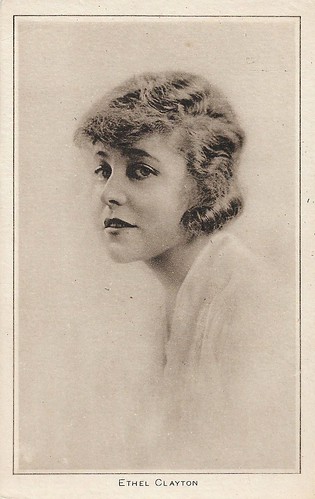
British postcard in the "Pictures" Portrait Gallery, London.
Ethel Clayton (1882-1966) was an American stage and screen actress and singer. In 1909 she started film acting with the company Essanay. After five films she left Essanay and the film sets, but in 1912 she was lured back, but now to the company Lubin, first acting in For the Love of a Girl (1912), opposite Harry Myers, with whom she would often act together. Clayton got first billing or was at least the female lead in many films. After 27 more shorts at Lubin, she acted in her first feature there, When the Earth Trembled (Barry O'Neil, 1913), a family and business drama against the background of the 1906 San Francisco earthquake. More shorts but also features followed, such as The Lion and the Mouse (Barry O'Neill, 1914) and The Fortune Hunter (Barry O'Neill, 1914). Clayton stayed with Lubin until 1916, when she first shifted to World Film, followed by Paramount and other companies.
A heavy billed as Babe Hardy
Some of the pioneer actors who worked for Lubin included Romaine Fielding, Ed Genung, Harry Myers, Florence Hackett, Alan Hale, Arthur V. Johnson, Lottie Briscoe, Florence Lawrence, Ethel Clayton, Gladys Brockwell, Edwin Carewe, Ormi Hawley, Rosemary Theby, Betty Brice, Alice Mann, and Pearl White.
Lubin films also marked the first film appearance of Oliver Hardy, who started working at Lubin's Jacksonville, Florida studio in 1913. Hardy's first onscreen appearance was in Outwitting Dad (1914) where he was billed as O. N. Hardy. In many of his later films at Lubin, he was billed as “Babe Hardy”. He was most often cast as “the heavy” or the villain and had roles in comedy shorts, appearing in some 50 short one-reeler films at Lubin by 1915.
However, the company's downfall came even faster than its meteoric rise. Despite Lubin's efforts, by early 1912, the Lubin Manufacturing Company began to fall behind the more progressive members of the Motion Picture Patents Company and other independent producers of films in terms of overall quality and film length. Lubin was not as adroit as its competitors in shifting to quality feature-length films.
Also, a disastrous fire at its main studio in June 1914, damaged nearby buildings and destroyed the negatives for a number of unreleased new films, which severely hurt the business. When World War I broke out in Europe in September of that year, Lubin and other American filmmakers', lost a large source of income from these foreign sales. In 1915, Lubin was forced to begin consolidating his business and he closed the studios one-by-one.
Despite efforts of one employee to move the company to California, the eastern branch of the Lubin Manufacturing Company would remain the dominant base of operations. The Lubin company entered into an agreement to form a film distribution partnership, with Vitagraph Studios, Selig Polyscope Company, and Essanay Studios, known as V-L-S-E, Incorporated. Lubin also tried to re-release popular films as well as to sign more famous actors, such as Charlie Chaplin.
However, none of these efforts changed the company's fate. The United States Supreme Court rulings against the monopoly of the Motion Picture Patents Company spelled the end of Lubin's business. After making more than a thousand films the corporation was forced into bankruptcy and on 1 September 1916, the Lubin Manufacturing Company closed its doors for good. Siegfried Lubin went back to his work as an optician and died in 1923.

American postcard by Kraus Manufacturing Company, New York, 1913. Photo: Lubin.
Peter Lang (1859-1932) was an American actor. After some 25 shorts at Lubin, Lang's first feature at Lubin was When the Earth Trembled (Barry O'Neil, 1913). After that film, Lang shifted to Famous Players, playing in feature-length dramas like An American Citizen (1914), starring John Barrymore. But in 1914 Lang was back at Lubin for features there such as Michael Strogoff (Lloyd B. Carleton, 1914), and the Western The Valley of Lost Hope (Romaine Fielding, 1916).

American postcard published by Kraus Mfg. Co., N.Y. Photo: Lubin. Collection: Marlene Pilaete.
Florence Williams was a matron-like American silent film actress. She started her film career at the Lubin Manufacturing Company in the short comedy Getting Married (Arthur Hotaling, 1913) with Robert Fischer and Jennie Nelson. According to IMDb, she was known for the short drama The Wolf (Barry O'Neil, 1914), The College Widow (Barry O'Neil, 1915) with Ethel Clayton, and The Sporting Duchess (Barry O'Neil, 1915). She ended her film career with Otto the Sleuth (Edwin McKim, 1916), an episode of the Otto comedies with Davy Don as Otto.

American postcard published by Kraus Mfg. Co., N.Y. Photo: Lubin. Collection: Marlene Pilaete.
Howard M. Mitchell (1883-1958) was an American actor and film director. He appeared in 270 films between 1910 and 1952 and directed 38 silent films between 1915 and 1927. Howard M. Mitchell was born in 1883 in Pittsburgh, Pennsylvania. In 1909, he started his film career as an actor in the Lubin Manufacturing Company's Martyr or Crank? (N.N., 1909) with Harry Myers. For Lubin followed several short films such as The Irish Boy (1910), The Miner's Sweetheart (1910), and A Change of Heart (1910) with Spottiswoode Aitken. In 1911 he married actress Mary Land. Till 1916, he appeared in many short films for Lubin and Thanhouser. He then focused on directing and made such films as The Mother Heart (1921), Lovetime (1921), and Romance Ranch (1924). In 1927, Howard M. Mitchell returned to the screen in A Bowery Cinderella (Burton L. King, 1927). During the following decades, he worked as a bit player in countless films. He could be glimpsed in films like They Won't Forget (Mervyn LeRoy, 1937) with Claude Rains, The Great Waltz (Julien Duvivier, 1938) with Luise Rainer, and Queen of the Mob (James P. Hogan, 1940) with Ralph Bellamy. His final film appearance was in Carrie (William Wyler, 1952) starring Laurence Olivier and Jennifer Jones. Howard M. Mitchell died in 1958 in Hollywood, California.

American postcard published by Kraus Mfg. Co., N.Y. Photo: Lubin. Collection: Marlene Pilaete.
Lottie Briscoe (1883-1950) was a raven-haired American stage and silent screen actress. After starting her film career with Essanay in Chicago, Lottie worked for the Lubin Company from 1912 to 1915. There she formed a popular couple with matinée idol Arthur V. Johnson. Briscoe appeared in over 94 motion pictures. Lottie Briscoe was born in 1883 in St. Louis, Missouri. Her parents were Mr. and Mrs. T. D. Briscoe. Her father may have been involved in theatre work and her mother was known to the theatre community as a likable stage mother. A sister, Olive Helen Briscoe, had long a career in vaudeville as a singer and comedian. Lottie was a child performer from the age of four. She then graduated to ingénue roles at the Orpheum Theater in Philadelphia. Around 1909 Briscoe, along with Harry McRae Webster, joined the fledgling Essanay Studios in Chicago. At least two films during this period, both one-reelers from January 1911, are known to exist today; The Sophomore’s Romance and A Sin Unpardonable. From 1912 to 1915, Lottie worked for the Lubin Company, where she was popularly paired with matinée idol Arthur V. Johnson. Their films include The Country School Teacher (N.N., 1912) and The Power of the Cross (Arthur V. Johnson, 1913). Their most ambitious project together during this period was probably The Belovéd Adventurer (1914), a 15-episode serial written by Emmett Campbell Hall. In January 1916, Arthur V. Johnson died shortly after the release of their latest film, the Maie B. Hovey story The Lost Rose (1919). Lottie Briscoe left the film business. In 1918, she only briefly returned to play Gertie Farish in her final film, The House of Mirth (Albert Capellani, 1918). On the stage, she played the title role in a domestic comedy by George Kelly entitled 'Mrs. Wellington's Surprise'. In 1922 Briscoe signed to appear in a leading role with William Faversham in 'The Squaw Man'. She continued to appear in Vaudeville before being confined at home due to a debilitating illness. Lottie Briscoe died in 1950 in New York City, at the age of 66. She was married to Harry McRae Webster (1903-1911) and Harry Mountford (1921-). Harry McRae Webster was a motion picture director of some note before he was sued in the early 1920s by a film studio over the unauthorised use of nude models in one of his movies. Mountford was formerly an executive secretary of the White Rats Actors Union which was disbanded in 1930.

American postcard published by Kraus Mfg. Co., N.Y., no. K 437. Photo: Lubin. Collection: Marlene Pilaete.
American actress Marie Weirman or Marie Wierman (1893–1956) started her film career at the Lubin Manufacruring Company in 1912. Marie Weirman was a silent film actress, who started her career at the Lubin Manufacturing Company in such short dramas as The Blacksmith (Wilbert Melville, 1912). For other companies, she later made Fanny's Melodrama (Wilfrid North, Wally Van, 1914), The Marble Heart (George Lessey, 1915) with King Baggott, and Under Southern Skies (Lucius Henderson, 1915) starring Mary Fuller. According to IMDb, she made nearly 40 films. However, Wikipedia tells another story. In 1912, Marie Wierman became a member of the Lubin Stock Company. She was born Marie Elizabeth Wierman in 1983 in Philadelphia. Marie was the daughter of Mary E. Wierman. From 1912, she was a member of the Lubin Stock Company and worked on films in Maine. As Mary Warren, she was an actress based in Hollywood who appeared in about two dozen silent films between 1918 and 1924, including The Sea Panther (1918), The Vortex (1918), An Honest Man (1918), All Night (1918), What Every Woman Wants (1919), The Final Close-Up (1919), Girls (1919), Prudence on Broadway (1919), The City of Comrades (1919), The Prince of Avenue A (1920), Guile of Women (1921), Voices of the City (1921), Come on Over (1922), The Man Who Won (1923), The Wolf Man (1923), Cupid's Fireman (1923), and In Love with Love (1924). She also made one sound film, Irish Hearts (1934). In 1916, Mary Warren married character actor Lee Phelps. They had two daughters, Marilee and Patricia. Lee Phelps died in 1953. Mary Warren died in 1956, aged 62 years, in Los Angeles, California. She was the mother of actress Marilee Phelps and grandmother of music supervisor Madeleine Smith.
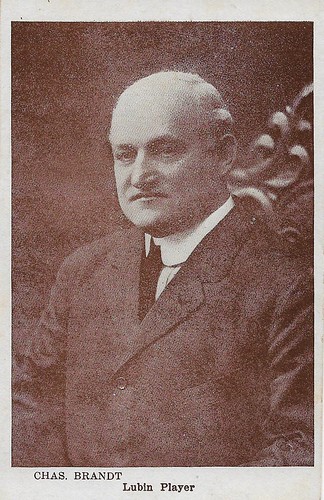
American postcard.Photo: Lubin. Stamp on the back: Empire Theatre.
Charles Brandt (1862-1924) was a well-known stage performer from the 1880s. From 1911, the cheerful, white-haired gentleman starred and supported in more than 60 films for Lubin, often seen as professionals or fathers in dramas and comedies. He first appeared in His Chorus Girl Wife (Harry Solter, 1911) starring Florence Lawrence. Perhaps he will be best remembered in the role of Sam Graham in The Fortune Hunter (Barry O'Neil, 1914) starring William Elliott and Ethel Clayton. In 1917 Brandt moved to the World Film Company, followed by the Betzwood Film Co in 1918. He was last seen in the First National production The Master Mind (Kenneth S. Webb, 1920) starring Lionel Barrymore.
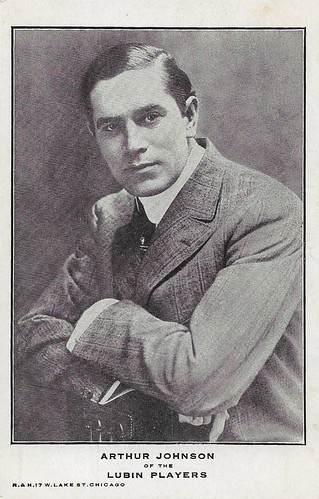
American postcard by R & H, Chicago. Photo: Lubin.
Arthur V. Johnson was born in 1876 in Cincinnati, Ohio, as Arthur Vaughen Johnson. He was a highly prolific actor and director, known for his work at the pre-Hollywood companies of Edison, American Biograph, and Lubin. His high productivity took his toll: in 1915 he had a nervous breakdown due to overwork, he stopped his career, and in early 1916 he died of TBC, almost forty.
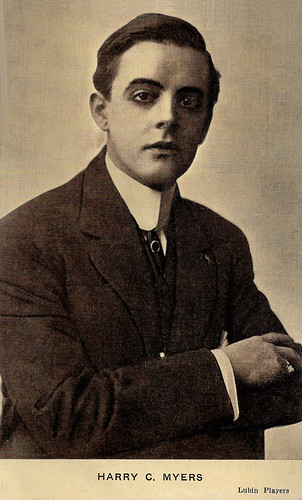
American postcard by Kraus Manufacturing Co., New York. Photo: Lubin.
Harry C. Myers (1882-1938) was an American film actor and director, sometimes credited as Henry Myers. He had been a theatre actor for 10 years before he made his film debut for Lubin in 1909. Myers went on to direct his own comedy shorts featuring him and his wife, Rosemary Theby, for Universal, the Vim Comedy Company, and Pathé studios. Later he played the eccentric alcoholic millionaire in Chaplin's City Lights (1931).
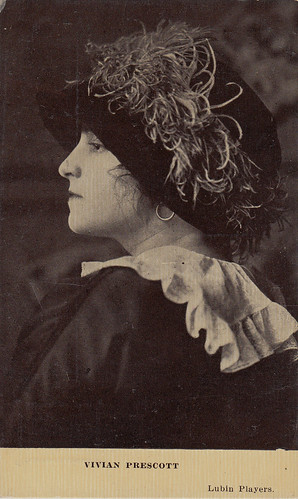
American postcard published by Kraus Mfg. Co., N.Y., no. K 445. Photo: Lubin. Collection: Marlene Pilaete.
Vivian Prescott was an Italian born American actress. She appeared in 202 films between 1909 and 1917. Vivian Prescott was born in Genoa, Italy. She spent some time on the American stage before entering silent pictures. She started at the Biograph comedy where D.W. Griffith directed her in such short silent films as Winning Back His Love (D. W. Griffith, 1910), Fisher Folks (D. W. Griffith, 1911), and The Primal Call (D. W. Griffith, 1911), all starring Wilfred Lucas. She also played in The Sands of Dee (D. W. Griffith, 1912) starring Mae Marsh and Robert Harron. The film is used in the opening scene of the psychological horror film The Spiral Staircase (Robert Siodmak, 1946) in a recreation of early film exhibition. The Spiral Staircase is set in 1906, making the appearance of this 1912 film anachronistic. Vivian Prescott moved to Independent Moving Pictures (IMP) where she appeared in The Man of the West (Otis Turner, 1912) starring King Baggot. For Lubin, she made a series of short comedies including Bob Builds a Chicken House (N.N., 1913), Bob Buys an Auto (Joseph W. Smiley, 1913) and Bob Builds a Boat (1913). In this series, Robert Fischer starred as Bob, and Prescott played his daughter. She also appeared in Man's Enemy (Frank Powell, 1914) starring Lillian Gish. Her final film was the short A Gentle Volunteer (Ben F. Wilson, 1916). Between 1909 and 1916 she made over 200 films. Her off-screen pseudonym was Violet Crawford.
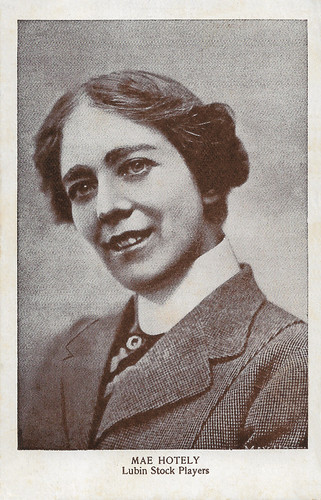
American postcard. Photo: Lubin.
Mae Hotely (1872-1954) was a brunette early silent screen comedienne, who starred in films for Lubin, produced by her husband Arthur Hotaling out of Jacksonville, Florida. She appeared in 85 films between 1911 and 1929.
Sources: Philadelphia Area Archives Research Portal (PAARP), Wikipedia, and IMDb.
Check out our earlier Before Hollywood posts: Vitagraph, Essanay, and Biograph.
Great insights. Managing a remote team can be challenging, but your tips are spot-on for enhancing productivity and team cohesion, even in the unique setting of a film studio rental. Communication and setting clear expectations are key, and your emphasis on staying connected and prioritizing tasks is invaluable. Thanks for sharing these.
ReplyDelete